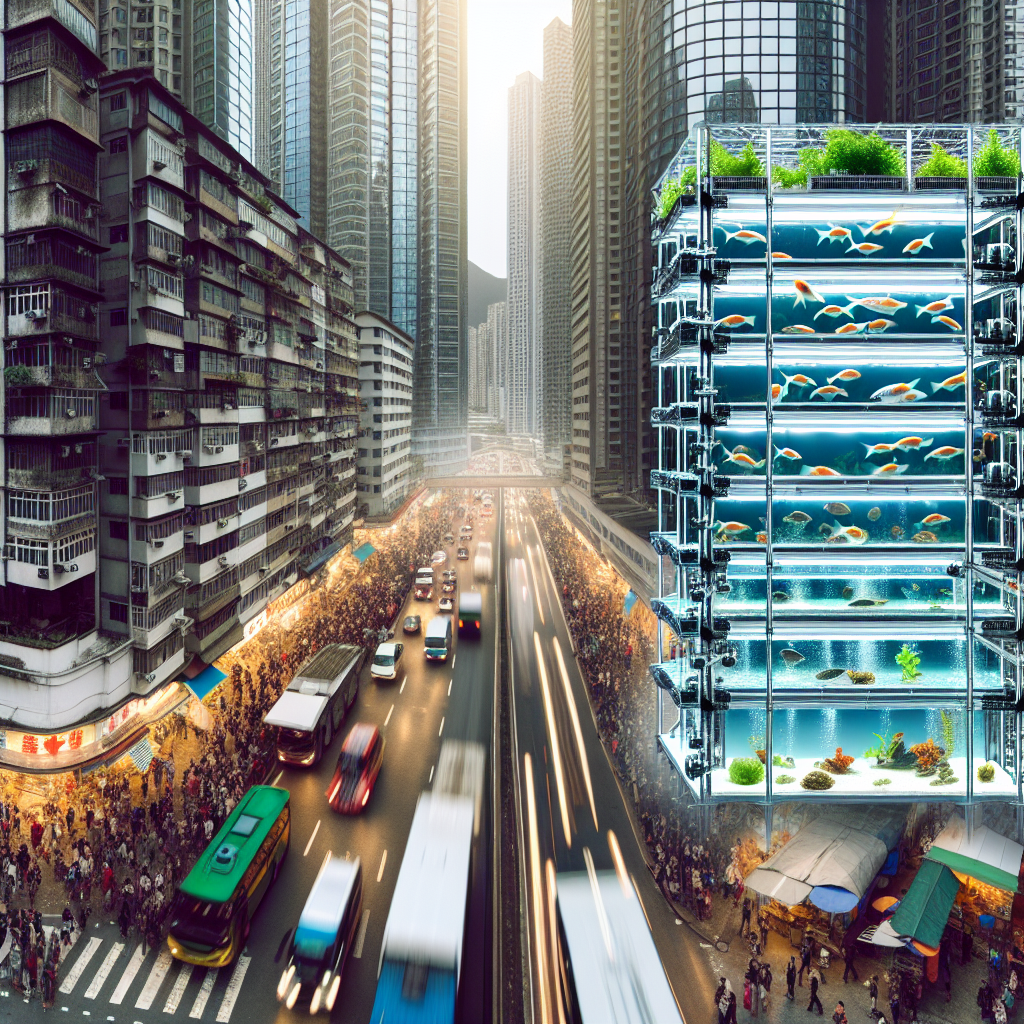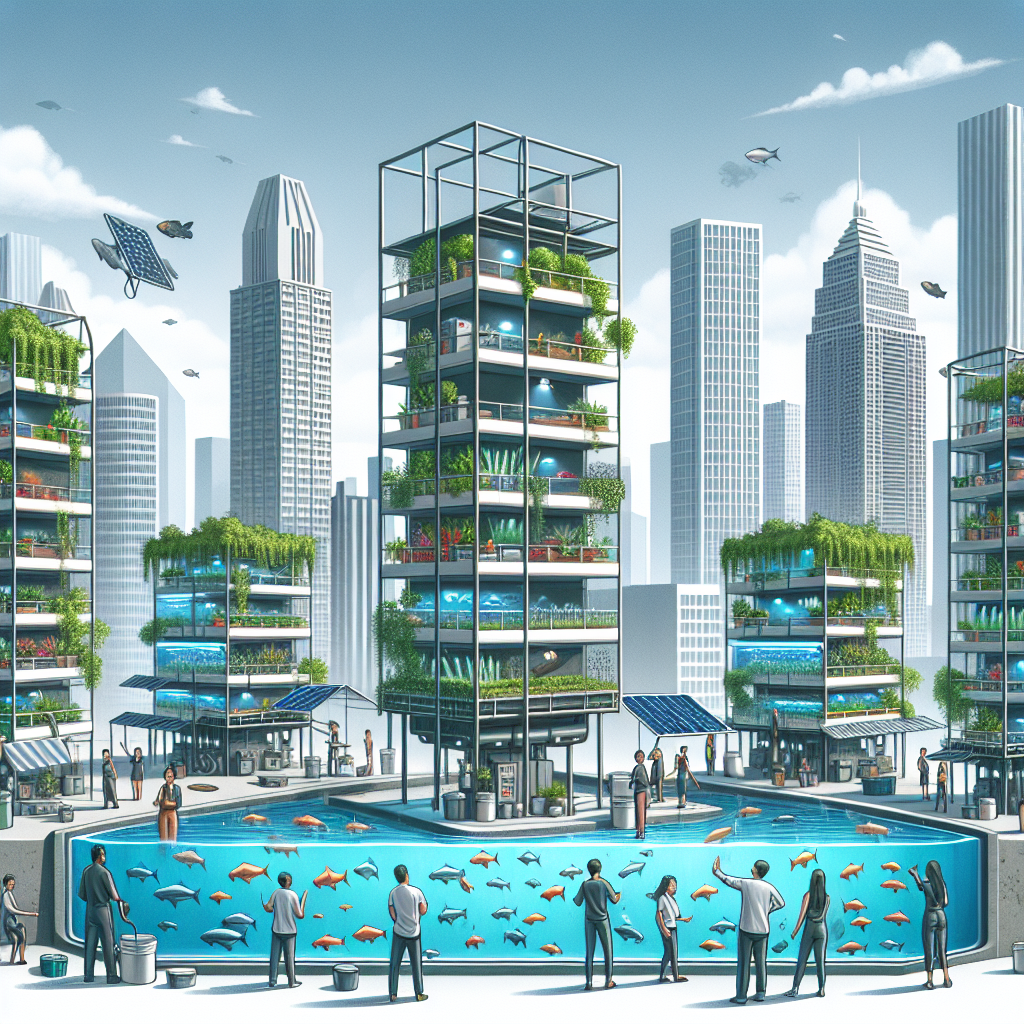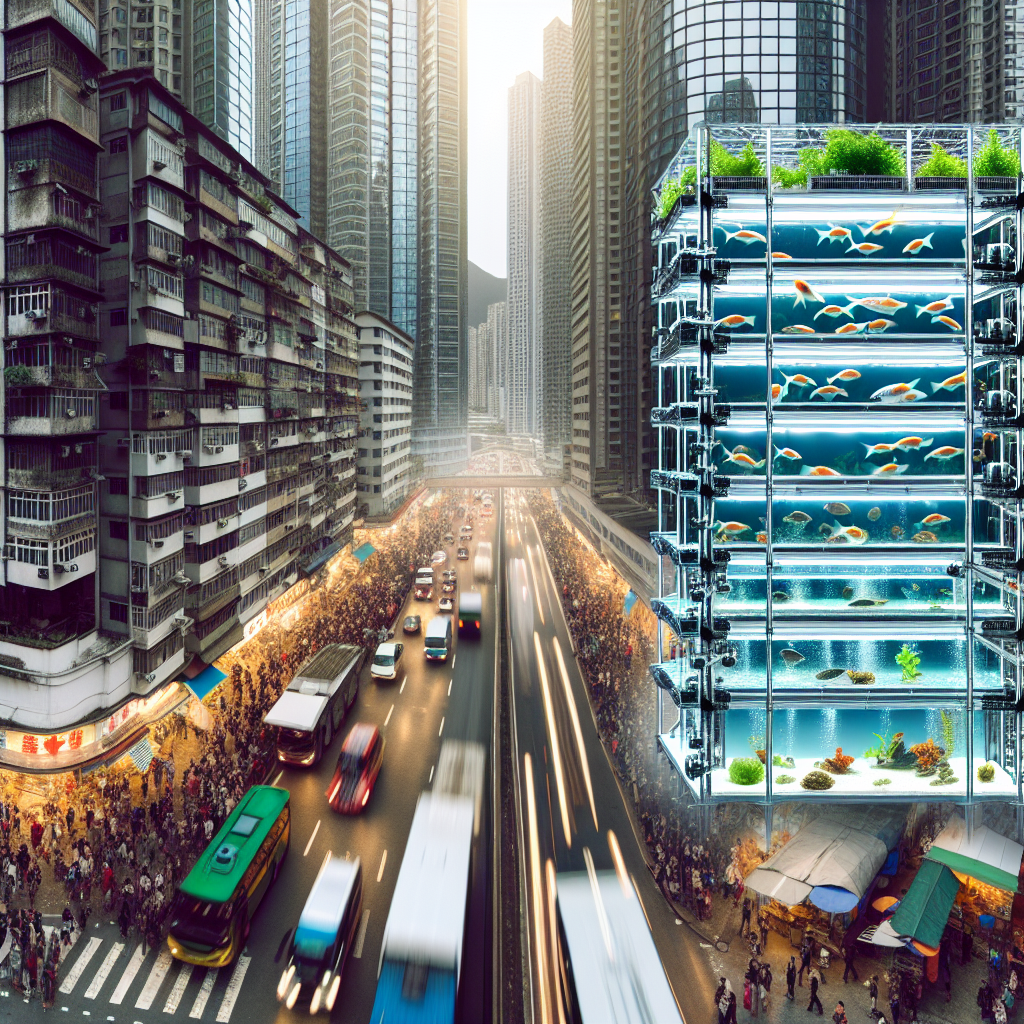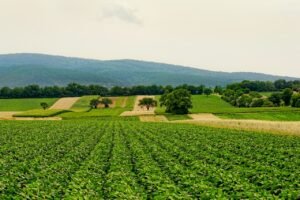
Imagine being able to grow your own fish in the comfort of your own urban space, no matter how small it may be. Urban fish farming and aquaculture hold immense potential for transforming the way we think about food production in limited spaces. Whether you live in a city apartment or a suburban home with a tiny backyard, the possibilities for cultivating fish and reaping the benefits of fresh and sustainable seafood are endless. In this article, we will explore the exciting world of urban fish farming and delve into the various ways it can be achieved, even in the smallest of spaces. Get ready to discover a whole new way to bring food production into urban environments!

Understanding Urban Fish Farming
Urban fish farming refers to the practice of cultivating fish in urban or densely populated areas, typically in limited spaces such as rooftops, basements, or specially designed facilities. It presents an innovative solution to the growing food demand in urban areas while addressing the challenges of limited land availability. By utilizing advanced technologies and sustainable practices, urban fish farms contribute to the production of fresh and locally sourced seafood, thereby reducing the strain on natural fish stocks.
Importance of Urban Fish Farming in Limited Spaces
Urban fish farming plays a crucial role in ensuring food security in densely populated areas where traditional farming practices may not be feasible. With the global population rapidly increasing and urbanization on the rise, it becomes essential to explore alternative means of food production. By utilizing limited spaces for fish farming, urban communities can have direct access to locally grown fish, reducing their dependence on imported seafood and supporting the local economy.
Benefits of Urban Fish Farming
Sustainable Food Production
Urban fish farming allows for sustainable food production by bringing the source closer to the consumer. Fresh fish can be produced and distributed within the urban area, reducing the carbon footprint associated with long-distance transportation. Additionally, by implementing environmentally friendly practices such as recirculating aquaculture systems (RAS) and aquaponics, urban fish farms minimize water usage and improve overall resource efficiency.
Reduced Strain on Natural Fish Stocks
Overfishing and depletion of natural fish stocks have become major concerns globally. Urban fish farming alleviates this strain by providing a local, controlled environment for fish cultivation. By relying on a closed-loop system, where water is continuously recycled, the need for capturing fish from the wild is significantly reduced. This approach not only helps conserve natural resources but also contributes to the long-term sustainability of fish populations.
Potential for Employment Opportunities
Urban fish farming can generate employment opportunities, particularly in communities with limited job prospects. From skilled technicians responsible for maintaining the fish farm systems to sales and distribution personnel, these operations require a diverse range of roles. By creating local job opportunities, urban fish farms can contribute to the economic development of the community and reduce unemployment rates.
Promotion of Local Economy
Investing in urban fish farming fosters local economic growth. By producing fish within the city, farm owners can establish direct relationships with local markets, restaurants, and consumers. This direct-to-market approach not only ensures a higher profit margin for farmers but also stimulates the local economy. Additionally, urban fish farms can collaborate with other local businesses, such as restaurants and vertical farming operations, creating a mutually beneficial network of sustainability-focused enterprises.
Challenges of Urban Fish Farming
Space Limitations
One of the primary challenges of urban fish farming is the scarcity of available land. With urban areas often characterized by limited space options, fish farms need to be designed with vertical or compact layouts in mind. However, innovative solutions such as utilizing rooftops, repurposing unused basements, and integrating fish tanks with existing infrastructure can help overcome these spatial limitations.
Water Supply and Filtration
Urban fish farms must ensure a consistent and reliable water supply while maintaining optimal water quality for fish growth. Access to clean water can be a challenge in densely populated areas, and reliance on municipal water sources may not always be viable. Implementing advanced water filtration systems and exploring alternative water sources such as rainwater harvesting can help address this challenge and ensure the health and well-being of the fish.
Managing Waste and Effluents
Proper waste management is essential in urban fish farming to prevent pollution and maintain environmental sustainability. Fish farms generate waste in the form of uneaten feed, feces, and excess nutrients. Effective waste management systems, such as settling tanks and biological filters, should be in place to remove and treat these byproducts. Additionally, innovative approaches like utilizing the waste as fertilizer for neighboring urban gardens or converting it into biogas can further enhance the sustainability of urban fish farms.
Regulatory and Legal Considerations
Operating an urban fish farm involves complying with various regulations and legal requirements. These may include obtaining permits, licenses, and certifications, as well as adhering to health and safety standards. Understanding and meeting these regulatory obligations is crucial for the successful establishment and operation of an urban fish farm. Working collaboratively with local authorities and seeking guidance from aquaculture experts can help navigate this complex landscape.
Limited Access to Natural Resources
Unlike traditional fish farms located in rural or coastal areas, urban fish farms face limitations in accessing natural resources. Availability of suitable fish feed, efficient electricity supply, and affordable energy sources may be challenging in urban settings. Developing partnerships with local suppliers, exploring sustainable feed options, and investing in renewable energy solutions are key strategies to mitigate these resource constraints and ensure the viability of urban fish farms.

Types of Urban Fish Farming Systems
Recirculating Aquaculture Systems (RAS)
Recirculating aquaculture systems (RAS) are an ideal choice for urban fish farming as they enable the efficient use of water and space. In RAS, water is continuously recirculated and treated, allowing for high-density fish farming with minimal water usage and waste discharge. By utilizing filtration systems to remove solids and maintaining optimal water quality parameters, RAS provides a controlled and sustainable environment for fish growth.
Vertical Integrated Aquaculture Systems
Vertical integrated aquaculture systems capitalize on vertical spaces in urban environments for maximizing fish production. These systems involve multi-level structures with fish tanks placed on top of each other. By utilizing vertical spaces, more fish can be cultivated within a limited footprint, making this an efficient and space-saving approach to urban fish farming.
Container-based Fish Farms
Container-based fish farms are a flexible and modular solution that can be easily implemented in urban areas. These fisheries utilize repurposed shipping containers or similar structures to house the fish. These containers can be stacked or placed side by side to optimize space utilization. Container-based fish farms benefit from their mobility, as they can be relocated, expanded, or adjusted according to the available space and market demand.
Aquaponics Systems
Aquaponics combines fish farming with hydroponics, creating a mutually beneficial system. In aquaponics, fish waste provides nutrients for the plants, while the plants act as natural filters, purifying the water for the fish. This symbiotic relationship allows for sustainable food production and resource conservation. Aquaponics systems are particularly suitable for urban environments, as they require minimal space and water usage compared to conventional farming methods.
Best Fish Species for Urban Fish Farming
Tilapia
Tilapia is a commonly cultivated fish species in urban fish farms due to its adaptability, fast growth rate, and mild flavor. These hardy fish can tolerate a wide range of water conditions and are well-suited for recirculating aquaculture systems. Tilapia is also known for its high protein content and low levels of saturated fat, making it a popular choice among health-conscious consumers.
Catfish
Catfish is another suitable option for urban fish farming, particularly in systems that incorporate aquaponics. This freshwater species is known for its resilience and fast growth rate. Catfish have a mild flavor with a slightly sweet undertone, appealing to a wide range of palates. Their ability to thrive in various water conditions makes them well-suited for urban farming, even in less controlled environments.
Trout
Trout is a coldwater fish that thrives in controlled environments, making it suitable for urban fish farms that can provide optimal water conditions. This species is known for its delicate texture and mild flavor, making it a popular choice among seafood enthusiasts. Trout farming requires careful monitoring of water temperature and quality, but its high market value and demand make it an attractive option for urban fish farming.
Salmon
Although salmon farming is typically associated with coastal areas, technological advancements have made it possible to cultivate salmon in urban environments. This high-value fish species is sought after worldwide for its rich flavor and nutritional benefits. Urban fish farms can utilize RAS or vertical aquaculture systems to create a controlled environment that mimics the requirements of salmon, ensuring optimal growth and quality.
Carp
Carp is a versatile fish species that adapts well to various environmental conditions, including urban fish farming. Carp is known for its robustness, fast growth, and ability to tolerate a wide range of water temperatures and qualities. This resilience, coupled with its relatively low production cost, makes carp an attractive option for urban fish farms aiming to maximize productivity in limited spaces.
Barramundi
Barramundi, also known as Asian sea bass, is a popular fish species for urban fish farming. It is sought after for its delicate flavor and firm texture. Barramundi can tolerate varying water conditions and is well-suited for recirculating aquaculture systems. Its high market value and popularity among consumers make it an excellent choice for urban fish farms aiming for premium seafood production.

Optimal Farming Practices
Water Quality Management
Maintaining optimal water quality is crucial for the success of urban fish farms. Regular monitoring of key parameters such as temperature, dissolved oxygen levels, pH, and ammonia concentration is essential. Implementing appropriate filtration and aeration systems ensures a healthy and conducive environment for fish growth. Additionally, proactive measures should be taken to prevent potential waterborne diseases or pathogens from affecting the fish population.
Feeding and Nutrition
Proper feeding and nutrition management are essential to maximize fish growth and health. Urban fish farms must provide nutritionally balanced diets tailored to the specific needs of the fish species being cultivated. Overfeeding should be avoided to minimize waste production and maintain water quality. Regular assessment of fish growth and nutritional requirements will help optimize feeding practices and minimize environmental impacts.
Monitoring and Control Systems
Utilizing advanced monitoring and control systems is vital for efficient operation and early detection of potential issues. Automated sensors and data collection systems can monitor parameters such as water quality, temperature, and feeding patterns. This real-time information allows fish farm operators to make informed decisions, optimize resource allocation, and promptly respond to any deviations from the desired parameters.
Disease Prevention and Control
Proactive disease prevention and control measures are essential in urban fish farming. Implementing biosecurity protocols, including regular health checks and quarantine procedures, helps minimize the risk of disease outbreaks. Proper sanitation and disinfection practices must be followed to maintain a clean and hygienic environment within the fish farm. Additionally, monitoring and regular health assessments can aid in early detection and treatment of any potential diseases.
Harvesting and Processing Techniques
Harvesting and processing techniques play a crucial role in maintaining the quality and freshness of the fish. Urban fish farms should adopt humane and efficient harvesting practices to minimize stress and ensure the highest possible quality. Implementing rapid chilling methods and proper packaging techniques will help preserve the fish’s texture and flavor during transportation and storage. Additionally, partnerships with local processing facilities can provide value-added opportunities for diversification and market reach.
Utilizing Vertical Spaces
Vertical Farming Structures
Utilizing vertical farming structures is an effective way to maximize space efficiency in urban fish farming. Vertical structures, such as multi-level shelves or racks, can be utilized to accommodate fish tanks, thereby increasing the production capacity within a limited footprint. Vertical farming also allows for easy monitoring and maintenance of fish tanks at different heights, optimizing space and facilitating workflow.
Multi-level Fish Tanks
Multi-level fish tanks, designed specifically for urban fish farming, allow for increased fish stocking densities by utilizing the available vertical space. These tanks can be stacked on top of each other, allowing for efficient use of limited areas. Care should be taken to ensure proper water circulation and filtration at each level to maintain optimal water quality and prevent any negative impacts on fish health.
Stackable Aquaponic Systems
Combining aquaponics with stackable systems presents a unique opportunity for urban fish farming. In this approach, fish tanks are stacked above or alongside hydroponic grow beds, creating an integrated system. Fish waste provides nutrients for the plants, while the plants purify the water for the fish. By utilizing vertical space in this manner, urban fish farms can maximize productivity while minimizing the overall footprint.

Maximizing Space Efficiency
Utilizing Rooftops for Fish Farming
Rooftops present an often underutilized space in urban environments that can be transformed into productive fish farms. By placing fish tanks on rooftops, urban fish farmers can make the most of available space. Careful consideration should be given to weight-bearing capacity, waterproofing, and structural integrity to ensure a safe and sustainable rooftop fish farming operation.
Innovative Land Use Strategies
Innovative land use strategies can be employed to optimize space efficiency in urban fish farming. Collaborations between fish farms and other urban agriculture initiatives, such as vertical or rooftop gardens, can maximize the use of available land. Sustainable urban planning that promotes mixed-use developments integrating residential, commercial, and agricultural spaces can create synergies and support the growth of urban fish farms.
Integrating Fish Tanks with Existing Infrastructure
To make efficient use of limited urban space, fish tanks can be integrated with existing infrastructure. By repurposing or retrofitting underutilized spaces such as basements, parking garages, or abandoned buildings, urban fish farms can establish their operations. This integration minimizes the need for additional construction and utilizes existing resources, making urban fish farming more feasible and cost-effective.
Case Studies: Successful Urban Fish Farms
Skye Fish Farm in New York City
Skye Fish Farm, located in the heart of New York City, is a successful example of urban fish farming. Utilizing a combination of RAS and vertical farming systems, Skye Fish Farm maximizes productivity in a limited urban space. The farm supplies premium quality fish to local restaurants and markets, reducing the reliance on imported seafood and supporting the local economy. Skye Fish Farm’s innovative approach serves as a model for sustainable and commercially viable urban fish farming.
Urban Fishery Project in Singapore
The Urban Fishery Project in Singapore has demonstrated the potential of fish farming in highly urbanized environments. By utilizing container-based fish farms, the project has transformed underutilized spaces into productive aquaculture systems. Through partnerships with local restaurants and markets, the project has successfully developed a sustainable and profitable urban fish farming operation. The Urban Fishery Project showcases the adaptability and versatility of urban fish farming models.
Floating Fish Farms in The Netherlands
The Netherlands has embraced urban fish farming through the establishment of floating fish farms in urban water bodies. These innovative farms utilize buoyant structures equipped with fish tanks, allowing for fish cultivation in urban canals and harbors. By utilizing underutilized water spaces, such as abandoned docks and canal edges, floating fish farms contribute to sustainable food production, reduce the strain on natural fish stocks, and promote local economic development.

Conclusion
Urban fish farming presents a promising solution to the challenges of limited space and increasing food demand in densely populated areas. By leveraging advanced technologies and sustainable practices, urban fish farms can produce fresh and locally sourced seafood, reduce the strain on natural fish stocks, and support the local economy. However, the success of urban fish farming relies on overcoming challenges such as space limitations, water supply, waste management, regulatory considerations, and limited access to resources. Through innovative farming systems, optimal practices, and efficient space utilization, urban fish farming can contribute to the future of sustainable aquaculture in limited spaces. The potential for growth and development in this sector is substantial, offering a viable pathway to enhance food security and promote environmentally conscious urban living.







